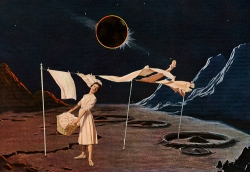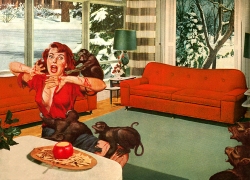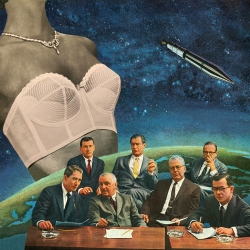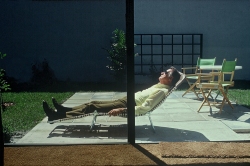Nadine Boughton
Visit the series pages below to see a slideshow of selected works and additional commentary by the artist.
Boughton’s hand-cut collages are unique. Limited edition prints of her digital collages are available in several sizes, and edition sizes vary with the series. Inquire for details.

This series looks at the luxuries and pleasures of American life after WWII. Prosperity reigned, material consumption exploded, leisure time grew, and advertising portrayed us as “good” and “happy.”
Among my interests as I worked were the illusion of security, food as an object of desire and comfort, the portrayal of women and domestic culture, and the grip of materialism.
Among my interests as I worked were the illusion of security, food as an object of desire and comfort, the portrayal of women and domestic culture, and the grip of materialism.

Men’s adventure magazines of the 1950s and early 1960s are shocking, funny, ambiguously rich artifacts of popular culture. In this series, I examine them as narratives from the collective psyche, and consider how they would speak in the environment of orderly homes with sunny patios depicted in women’s magazines of the same era. Here is a collision of two worlds: “sweats" (as the men's magazines were called) meets Better Homes and Gardens.

In this series, I focus on gender polarities as depicted in popular magazines of the 1950s and early 1960s. Fortune magazine showed (and still shows) men’s world of wealth, industry, and big ideas. Its advertisements were awash with imagery of invention and the glamour of executives. Women’s magazines of that time centered on the home, a place of dreamy interiority, shapely bras, hidden faces, and flowing fabrics.
My collages deconstruct these images of mid-century advertising, creating ambiguous narratives with humor and a dark edge, and revealing some of the different relationships men and women have to power, beauty, and longing. They playfully imagine the convergence of exterior and interior experiences, the domain of abstract ideas and the mystery of the female form
My collages deconstruct these images of mid-century advertising, creating ambiguous narratives with humor and a dark edge, and revealing some of the different relationships men and women have to power, beauty, and longing. They playfully imagine the convergence of exterior and interior experiences, the domain of abstract ideas and the mystery of the female form

Women draped in haute couture and posed in aristocratic settings were the face of a successful ad campaign that peaked in 1950s magazines. The product was Modess sanitary napkins, and the popular slogan was “Modess…because.”
These images of women were as far away from the body and bleeding as possible — in a word, they were “sanitized.”
My series of collages intends to reclaim women's bodies, especially in our politically charged times when women's rights are challenged and ownership of one's body is up for “grabs.”
These images of women were as far away from the body and bleeding as possible — in a word, they were “sanitized.”
My series of collages intends to reclaim women's bodies, especially in our politically charged times when women's rights are challenged and ownership of one's body is up for “grabs.”

This project documents my parents in their Florida retirement home. What began as a group of photographs I made of them over several mornings in 1979 grew into a series spanning almost twenty years.
